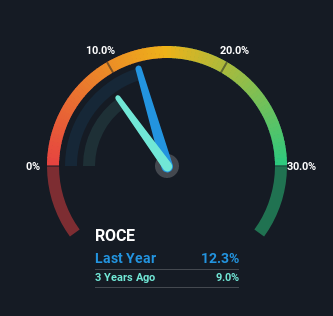- Hong Kong
- /
- Auto Components
- /
- SEHK:951
Returns On Capital At Chaowei Power Holdings (HKG:951) Have Stalled
Finding a business that has the potential to grow substantially is not easy, but it is possible if we look at a few key financial metrics. One common approach is to try and find a company with returns on capital employed (ROCE) that are increasing, in conjunction with a growing amount of capital employed. Ultimately, this demonstrates that it's a business that is reinvesting profits at increasing rates of return. That's why when we briefly looked at Chaowei Power Holdings' (HKG:951) ROCE trend, we were pretty happy with what we saw.
Understanding Return On Capital Employed (ROCE)
Just to clarify if you're unsure, ROCE is a metric for evaluating how much pre-tax income (in percentage terms) a company earns on the capital invested in its business. The formula for this calculation on Chaowei Power Holdings is:
Return on Capital Employed = Earnings Before Interest and Tax (EBIT) ÷ (Total Assets - Current Liabilities)
0.12 = CN¥993m ÷ (CN¥20b - CN¥12b) (Based on the trailing twelve months to December 2021).
Therefore, Chaowei Power Holdings has an ROCE of 12%. In absolute terms, that's a satisfactory return, but compared to the Auto Components industry average of 4.0% it's much better.
See our latest analysis for Chaowei Power Holdings

Historical performance is a great place to start when researching a stock so above you can see the gauge for Chaowei Power Holdings' ROCE against it's prior returns. If you're interested in investigating Chaowei Power Holdings' past further, check out this free graph of past earnings, revenue and cash flow.
The Trend Of ROCE
While the returns on capital are good, they haven't moved much. The company has employed 41% more capital in the last five years, and the returns on that capital have remained stable at 12%. Since 12% is a moderate ROCE though, it's good to see a business can continue to reinvest at these decent rates of return. Stable returns in this ballpark can be unexciting, but if they can be maintained over the long run, they often provide nice rewards to shareholders.
On a separate but related note, it's important to know that Chaowei Power Holdings has a current liabilities to total assets ratio of 60%, which we'd consider pretty high. This can bring about some risks because the company is basically operating with a rather large reliance on its suppliers or other sorts of short-term creditors. While it's not necessarily a bad thing, it can be beneficial if this ratio is lower.
The Bottom Line
To sum it up, Chaowei Power Holdings has simply been reinvesting capital steadily, at those decent rates of return. Yet over the last five years the stock has declined 48%, so the decline might provide an opening. For that reason, savvy investors might want to look further into this company in case it's a prime investment.
One more thing to note, we've identified 4 warning signs with Chaowei Power Holdings and understanding them should be part of your investment process.
If you want to search for solid companies with great earnings, check out this free list of companies with good balance sheets and impressive returns on equity.
New: AI Stock Screener & Alerts
Our new AI Stock Screener scans the market every day to uncover opportunities.
• Dividend Powerhouses (3%+ Yield)
• Undervalued Small Caps with Insider Buying
• High growth Tech and AI Companies
Or build your own from over 50 metrics.
Have feedback on this article? Concerned about the content? Get in touch with us directly. Alternatively, email editorial-team (at) simplywallst.com.
This article by Simply Wall St is general in nature. We provide commentary based on historical data and analyst forecasts only using an unbiased methodology and our articles are not intended to be financial advice. It does not constitute a recommendation to buy or sell any stock, and does not take account of your objectives, or your financial situation. We aim to bring you long-term focused analysis driven by fundamental data. Note that our analysis may not factor in the latest price-sensitive company announcements or qualitative material. Simply Wall St has no position in any stocks mentioned.
About SEHK:951
Chaowei Power Holdings
An investment holding company, manufactures and sells lead-acid motive batteries, lithium-ion batteries, and other related products in the People’s Republic of China.
Low risk and slightly overvalued.
Market Insights
Community Narratives



